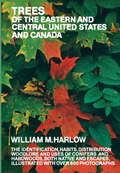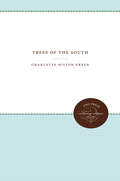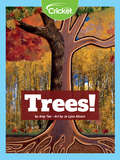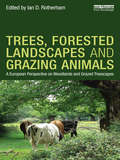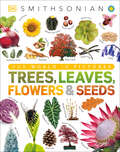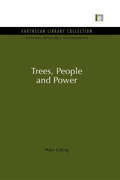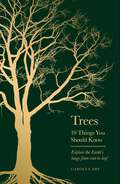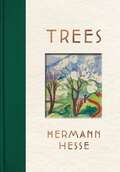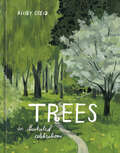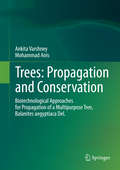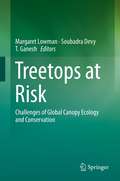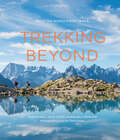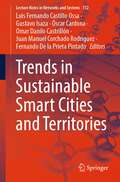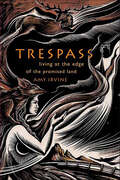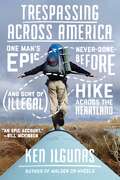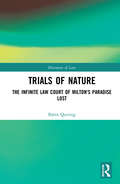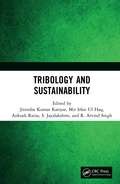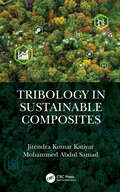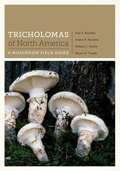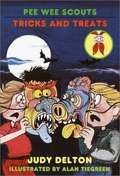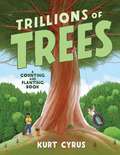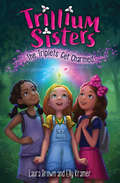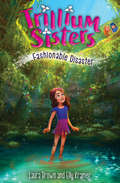- Table View
- List View
Trees of the Eastern and Central United States and Canada: The Identification, Habits, Distribution Woodlore And Uses Of Conifers And Hardwoods, Both Native And Escapes, Illustrated With Over 600 Photographs
by William M. HarlowThis is an extensively revised edition of the standard semipopular Trees of the Eastern and Central United States and Canada. It covers all the important native trees found in this area. A concise introduction provides all that you need to know for general identification of trees. Then, an eight-page, easy-to-use synoptic key enables you to locate at a glance the group or genus of any tree you are likely to encounter. Supplementary keys in the main text help you easily locate the various species.More than 140 different trees are described in detail, with information on general appearance, habit of growth, leaf forms, flowers, fruit, twig appearance, bark, and other features. Additional information includes habitat, distribution by states, commercial use, and even woodlore.Treatment throughout this fascinating book is semipopular; it is neither a slight sketch, nor a monograph for the specialist. It is a middle-range book, carefully written for the intelligent reader who is sincerely interested in accurate information about trees. With it you will be able to identify at sight almost any tree, not only by group but also by species. You will be able to tell a sugar maple from a Norway maple, a black oak from a white oak, a horse-chestnut from a chestnut. You will know which trees have edible fruit, which are suitable for house plantings, what climate and drainage conditions trees need, and a multitude of facts about each of more than 250 trees.
Trees of the South
by Charlotte Hilton GreenGreen's book is a delightful introduction to a knowledge of trees. The emphasis is, to a large extent, on the unique characteristics of trees and on unusual facts concerning their history and use. There are two full pages of photographs for almost every tree described: one of the tree in its natural setting, the other of detail that will aid in identification.Originally published in 1939.A UNC Press Enduring Edition -- UNC Press Enduring Editions use the latest in digital technology to make available again books from our distinguished backlist that were previously out of print. These editions are published unaltered from the original, and are presented in affordable paperback formats, bringing readers both historical and cultural value.
Trees!
by Amy TaoCan you guess when trees stop growing–they don’t stop! Their massive roots keep them in the ground and require plenty of water, sunshine and nutrients from the soil to help them grow. Trees are the oldest, largest and tallest living things on Earth, with the oldest part of the tree being its strong, woody middle. Find out how a maple tree gets its start! How does a tree grow?
Trees, Forested Landscapes and Grazing Animals: A European Perspective on Woodlands and Grazed Treescapes
by Ian D. RotherhamIn this comprehensive book, the critical components of the European landscape – forest, parkland, and other grazed landscapes with trees are addressed. The book considers the history of grazed treed landscapes, of large grazing herbivores in Europe, and the implications of the past in shaping our environment today and in the future. Debates on the types of anciently grazed landscapes in Europe, and what they tell us about past and present ecology, have been especially topical and controversial recently. This treatment brings the current discussions and the latest research to a much wider audience. The book breaks new ground in broadening the scope of wood-pasture and woodland research to address sites and ecologies that have previously been overlooked but which hold potential keys to understanding landscape dynamics. Eminent contributors, including Oliver Rackham and Frans Vera, present a text which addresses the importance of history in understanding the past landscape, and the relevance of historical ecology and landscape studies in providing a future vision.
Trees, Leaves, Flowers and Seeds: A Visual Encyclopedia of the Plant Kingdom (DK Our World in Pictures)
by DKPacked with more than 1,000 incredible images and full of fascinating facts, this beautiful children&’s book takes you on an exciting expedition through the wonders of the plant kingdom.Have you ever wondered which plants eat insects? Or how cacti store water? How about which flowers look like bees? Or where is the tallest tree in the world? If you find yourself seeking the answers to these quirky questions and so many more, then Trees, Leaves, Flowers & Seeds may be the book for you! Explore the incredible world of plants, from the smallest seeds to the tallest trees, whilst you discover all about the weirdest, smelliest and deadliest flowers on our planet, with this engaging encyclopedia for children aged 9-12. Celebrate your child's curiosity as they explore:- Striking and detailed diagrams, drawings, and illustrations on every page - A highly visual approach to learning - An ideal combination of colorful diagrams with infographic text boxes- In association with The Smithsonian InstitutionThis captivating kids encyclopedia also takes a fun, more sideways look at some truly strange plants, such as trees with fruits like a giant&’s fingers, orchids that look like monkey faces, seeds that spin like helicopters, and trees that drip poison! The striking illustrations, photographs and diagrams featured throughout provide an optimum visual learning experience for both children and adults alike, accompanied by an array of fun facts all about your favorite flowers, plants, trees and more.This plant encyclopedia includes at-a-glance panels that provide a quick reference to all the stats, making this nature book an ideal combination of colorful diagrams and infographic text boxes. In association with DK Smithsonian, the text proves easily accessible for readers aged 9-12, yet can be enjoyed by the entire family, making this enthralling children&’s encyclopedia a beautiful and educational gift that can be passed down generations.Learn all about the world one picture at a time!If you like Trees, Leaves, Flowers & Seeds, then why not complete the collection? Part of the highly visual Our World In Pictures series, avid readers can dive into the world of dinosaurs with The Dinosaur Book, become a vehicle virtuoso with Cars, Trains, Ships and Planes and venture on a journey across the globe with Countries, Cultures, People & Places.
Trees, People and Power: Trees, People And Power (Natural Resource Management Set)
by Peter UttingBehind the headlines about the loss of tropical forests in Latin America lies a complex and fascinating story of the social pressures which cause it. Trees, People and Power looks at the various groups, interests and conflicts involved, and explores the repercussions for forestry, the environment and the livelihoods of the rural and urban poor. Until the social and political dimensions of deforestation and forest protection schemes are understood, measures to prevent or slow deforestation are likely to involve technical interventions which will prove ineffective in the long run, and may well result in further impoverishment and environmental degradation. Peter Utting takes a critical look at the experience of forest protection and tree planting in a number of countries and considers how social and political factors affect the feasability of such schemes. Many environmental projects and programmes have failed to balance concerns for the environment with those of human welfare. Until they do, it is unrealistic to expect any significant progress towards sustainable development. Peter Utting is a senior researcher coordinator with the United Nations Research Institute for Social Development. He is the author of Economic Adjustment under the Sandinistas (UNRISD, 1991) and Economic Reform and Third World Socialism (Macmillan, 1992). Originally published in 1993
Trees: 10 Things You Should Know
by Carolyn FryDiscover the wonders at the centre of our planet's ecosystem.In ten short and accessible essays, science and nature writer Carolyn Fry takes us on an awe-inspiring journey of the Earth's lungs. From what makes a plant a tree and the incredible impact of forests, to how trees are under attack and what we can do to save them, this book will enthral and inform on the monumental power of the humble tree.Trees: 10 things you should know is an essential introduction to why trees are so important, and why our lives depend on them!
Trees: An Anthology of Writings and Paintings
by Hermann HesseAn elegant collection of Hermann Hesse’s essays, poems, and passages on the subject of trees and nature, accompanied by thirty-one of his watercolor illustrations. Hermann Hesse understood trees to be symbols of transcendence and rebirth, of instinctive growth present in all natural life. This elegant collection of his essays, poems, and passages on trees, accompanied by thirty-one of his watercolor illustrations, reveals his inspired thoughts on nature, spirituality, and self-knowledge. Together, his writings and paintings mirror the seasons and landscapes as he experienced them, and help remind us that trees’ annual rings are representations of our own days’ struggle, happiness, and purpose. In the author’s words: “They struggle with all the force of their lives for one thing only: to fulfill themselves according to their own laws . . . Whoever has learned to listen to trees no longer wants to be one. He wants to be nothing except who he is.”
Trees: An Illustrated Celebration
by Kelsey OseidDiscover the wonder of trees—one of the most essential life forms on the planet—in this beautifully illustrated, entertaining, and educational guide from the acclaimed author of What We See in the Stars.Trees are fascinating: The oldest living organism on Earth is a tree, and forest biomes cover one-third of the Earth&’s surface. Trees provide fruit, spices, nuts, timber, shade, habitats, and oxygen, as well as absorbing carbon dioxide from the atmosphere. They can tap into fungal networks in the soil to care for each other by trading water and nutrients and to warn one another of drought and disease.In Trees: An Illustrated Celebration, celebrated artist and author Kelsey Oseid shows us just how vital trees are to the health and beauty of our planet. Her striking naturalistic art is accompanied by fun scientific facts: Some trees have thinner root hairs than human hairs; tree rings provide important information on supernovae and climate change; and you can identify many trees from their leaf shape alone. The world's most stunning, strange, and noteworthy trees—from mangroves and redwoods to baobabs and dragon trees—come to life in Oseid's elegant and playful style.Filled with captivating information and vivid, colorful illustrations, Trees: An Illustrated Celebration will delight and inspire nature lovers of all ages.
Trees: Propagation and Conservation
by Ankita Varshney Mohammad AnisPlant tissue culture is an essential component of Biotechnology which has gained unbeatable recognition in plant sciences for successful micropropagation and improvement of plant species, leading to the commercial application. A number of plant species have been investigated around the globe. This book presents current research on the application of in vitro technology in the improvement of Balanites aegyptiaca Del. , a medicinal plant of semi-arid tropics. The worldwide importance of forestry, summed to the lengthy generation cycles of tree species, makes unavoidable development of new technologies that complement conventional tree breeding programmes in order to obtain improved genotypes. Recently, a new set of tools has become available in the past 20 years that combined with traditional plant breeding will allow scientists to generate products that are genetically improved varieties of the future. These set of tools come under the general title of 'Biotechnology'. The three specific biotechnological tools have been successfully used in several programmes of plant conservation, namely, tissue culture techniques for in vitro propagation, the use of molecular markers to assess the degree of variability among population and techniques of long-term conservation such as encapsulation and cryopreservation. Plant tissue culture techniques are particularly relevant and become an alternative not only for large scale propagation of individuals that are threatened, reduce production costs and increase gains to the industry, but also to provide ecological advantages as in phytoremediation or in the establishment of artificial plantings in weed infested site. The book gives a complete documentation of the results and demonstration of Balanites aegyptiaca conducted by the authors over the past 5 years. The end-to-end approach developed through plant tissue culture techniques is reflected in the book and there has been a successful transfer of technology from lab to field. The authors hope that this information would provide valuable data and also be a reference material for future research activities in this area.
Trees: Their Natural History
by Peter ThomasTrees are familiar components of many landscapes, vital to the healthy functioning of the global ecosystem and unparalled in the range of materials which they provide for human use. Yet how much do we really understand about how they work? This 2000 book provides a comprehensive introduction to the natural history of trees, presenting information on all aspects of tree biology and ecology in an easy to read and concise text. Fascinating insights into the workings of these everyday plants are uncovered throughout the book, with questions such as how are trees designed, how do they grow and reproduce, and why do they eventually die tackled in an illuminating way. Written for a non-technical audience, the book is nonetheless rigorous in its treatment and will therefore provide a valuable source of reference for beginning students as well as those with a less formal interest in this fascinating group of plants.
Treetops at Risk: Challenges of Global Canopy Ecology and Conservation
by Margaret Lowman Soubadra Devy T. GaneshForest canopies not only support high terrestrial biodiversity but also represent a critical interface between the atmosphere and the earth. They provide goods and services to support diverse human communities and offer opportunities to explore sustainable use of these resources for many generations of local livelihoods. Forest canopies are important carbon sequestration units, and in this sense, serve as climate control for the planet. Canopies are important energy production centers for the planet, and serve as the basis for many food chains. The canopy can also act as a hook for education outreach and conservation, inspiring ecotourism through recreation and other sustainable uses such as treetop walks, zip lines, and birding. Despite these critical services provided by forest canopies, almost no dedicated research in the treetops was initiated until as recently as the late 1970s when single rope techniques were developed by mountaineering professionals and adapted for use in the canopy. Subsequently, an array of canopy access tools was designed in the 1980s and early 1990s that have opened up this "eighth continent" for global exploration and discovery. This volume uses the major findings of the 5th international canopy conference as a platform for organization, but it does not mimic the sessions and presentations of the conference itself. Instead, it builds on the important themes that emerged from the conference and solicits articles that represent future priorities and advancements for canopy science in the next decade. Despite the global efforts of hundreds of forest scientists over the past 3 decades, forests are degrading at an accelerated rate and biodiversity is increasingly threatened by human activities. Given these trends - despite the very best efforts of the world's best scientists - other approaches must be taken. This volume summarizes the issue of "treetops at risk" and assembles a global authorship to examine past accomplishments and future initiatives critical in forest conservation.
Trekking Beyond: Walk the World's Epic Trails
by Damian Hall Dave Costello Billi BierlingExplore the world’s most iconic walking destinations through stunning photographs and essays that capture the beauty and majesty of nature.Discover the epic drama of mountain trails, windswept coastal paths, dense forest walks and the immense canyons, glaciers and ocean vistas only your feet can take you to.Vivid essays introduce the world’s best trekking regions—from the Himalayas to the Andes, the wilds of the Scottish Highlands to the dusty Australian Outback—exploring the challenges of walking these paths, the history of their formation and the sense of exploration and wonder to be found along these distinctive routes. Each route is accompanied by stunning photography, showcasing the variety of terrains and their magnificent vistas.“An absolute ‘must’ for armchair travelers, aspiring mountaineers, and ambitious world travelers.” —Midwest Book Review
Trends in Sustainable Smart Cities and Territories (Lecture Notes in Networks and Systems #732)
by Juan Manuel Corchado Rodriguez Gustavo Isaza Luis Fernando Castillo Ossa Óscar Cardona Omar Danilo Castrillón Fernando De la Prieta PintadoThis book presents the latest scientific and technical advances in the fields of Smart Cities and Smart Territories. It shows outcomes of 2nd Sustainable Smart Cities and Territories International Conference in Manizales (Colombia) on June 21–23, 2023. The concept of smart cities, which emerged in the early 2000s, attempts to solve these challenges by implementing information and communication technologies. The initial concept of smart cities focused on the modernization of megacities.
Trespass: Living at the Edge of the Promised Land
by Amy IrvineTrespass is the story of one woman's struggle to gain footing in inhospitable territory. A wilderness activist and apostate Mormon, Amy Irvine sought respite in the desert outback of southern Utah's red-rock country after her father's suicide, only to find out just how much of an interloper she was among her own people. But more than simply an exploration of personal loss, Trespass is an elegy for a dying world, for the ruin of one of our most beloved and unique desert landscapes and for our vanishing connection to it. Fearing what her father's fate might somehow portend for her, Irvine retreated into the remote recesses of the Colorado Plateau—home not only to the world's most renowned national parks but also to a rugged brand of cowboy Mormonism that stands in defiant contrast to the world at large. Her story is one of ruin and restoration, of learning to live among people who fear the wilderness the way they fear the devil and how that fear fuels an antagonism toward environmental concerns that pervades the region. At the same time, Irvine mourns her own loss of wildness and disconnection from spirituality, while ultimately discovering that the provinces of nature and faith are not as distinct as she once might have believed.
Trespassing Across America: One Man's Epic, Never-Done-Before (and Sort of Illegal) Hike Across the Heartland
by Ken IlgunasTold with sincerity, humor, and wit, Trespassing Across America is both a fascinating account of one man's remarkable journey along the Keystone XL pipeline and a meditation on climate change, the beauty of the natural world, and the extremes to which we can push ourselves--both physically and mentally. It started as a far-fetched idea--to hike the entire length of the proposed route of the Keystone XL pipeline. But in the months that followed, it grew into something more for Ken Ilgunas. It became an irresistible adventure--an opportunity not only to draw attention to global warming but also to explore his personal limits. So in September 2012, he strapped on his backpack, stuck out his thumb on the interstate just north of Denver, and hitchhiked 1,500 miles to the Alberta tar sands. Once there, he turned around and began his 1,700-mile trek to the XL's endpoint on the Gulf Coast of Texas, a journey he would complete entirely on foot, walking almost exclusively across private property.Both a travel memoir and a reflection on climate change, Trespassing Across America is filled with colorful characters, harrowing physical trials, and strange encounters with the weather, terrain, and animals of America's plains. A tribute to the Great Plains and the people who live there, Ilgunas's memoir grapples with difficult questions about our place in the world: What is our personal responsibility as stewards of the land? As members of a rapidly warming planet? As mere individuals up against something as powerful as the fossil fuel industry? Ultimately, Trespassing Across America is a call to embrace the belief that a life lived not half wild is a life only half lived.
Trials of Nature: The Infinite Law Court of Milton's Paradise Lost
by Björn QuiringFocusing on John Milton’s Paradise Lost , this book investigates the meta-phorical identifi cation of nature with a court of law – an old and persistent trope, haunted by ancient aporias, at the intersection of jurisprudence, phi-losophy and literature. In an enormous variety of texts, from the Greek beginnings of Western literature onward, nature has been described as a courtroom in which an all- encompassing trial takes place and a universal verdict is executed. The first, introductory part of this study sketches an overview of the metaphor’s development in European history, from antiquity to the seventeenth century. In its second, more extensive part, the book concentrates on Milton’s epic Paradise Lost in which the problem of the natural law court finds one of its most fascinating and detailed articulations. Using conceptual tools provided by Hannah Arendt, Walter Benjamin, Hans Blumenberg, Gilles Deleuze, William Empson and Alfred North Whitehead, the study demonstrates that the conflicts in Milton’s epic revolve around the tension between a universal legal procedure inherent in nature and the positive legal decrees of the deity. The divine rule is found to consolidate itself by Nature’s supple-mentary shadow government; their inconsistencies are not flaws, but rather fundamental rhetorical assets, supporting a law that is inherently “double- formed”. In Milton’s world, human beings are thus confronted with a twofold law that entraps them in its endlessly proliferating double binds, whether they obey or not. The analysis of this strange juridical structure can open up new perspectives on Milton’s epic, as well as on the way legal discourse tends to entangle norms with facts and thus to embed itself in human life. This original and intriguing book will appeal not only to those engaged in the study of Milton, but also to anyone interested in the relationship between law, history, literature and philosophy.
Tribology and Sustainability
by S. Jayalakshmi R. Arvind Singh Jitendra Kumar Katiyar Ankush Raina Mir Irfan Ul HaqTribology and Sustainability brings a vision of promoting a greener, cleaner and eco-friendly environment by highlighting sustainable solutions in tribology via the development of self-lubricating materials, green additives in lubricants, natural fibre-reinforced materials and biomimetic approaches. Backed by supporting schematic diagrams, data tables and illustrations for easy understanding, the book focuses on recent advancements in tribology and sustainability. Global sustainability and regional requirements are addressed through chapters on natural composites, green lubricants, biomedical systems and wind energy systems, with a dedicated chapter on a global sustainability scenario. FEATURES Highlights sustainability via new tribological approaches and how such methods are essential Covers the theoretical aspects of various tribological topics concerning mechanical and material designs for energy-efficient systems Includes practical global sustainability based on the regional requirements of tribological research and sustainable impact Reviews the tribology of green lubricants, green additives and lightweight materials Discusses topics related to biomimetics and biotribology Tribology and Sustainability will assist researchers, professionals and graduate students in tribology, surface engineering, mechanical design and materials engineering, including mechanical, aerospace, chemical and environmental engineering.
Tribology in Sustainable Composites
by Jitendra Kumar Katiyar Mohammed Abdul SamadTribological performance of sustainable composites depend upon external parameters such as interface and environmental temperature, contact pressure and behavior of contact materials at interface and so forth. This book covers sustainable composites and bio- composites in terms of proper selection of reinforcements, methods to improve the thermal and mechanical properties, techniques for uniform dispersion of the reinforcements and their tribological performance. Also, it details the testing and damage characterization methods of these sustainable composites. Features: 1. Presents fundamental knowledge of sustainable composites, including chemical composition, structural features and fabrication techniques. 2. Provides an analytical overview of the different types of characterization techniques and tribological methods. 3. Provides an extensive review on bio- composite properties and their tribological performance for biomedical application. 4. Contains extensive reviews on cutting- edge research on lightweight materials for future applications in a variety of industries and their tribological performance. 5. Provides the application of sustainable composites in various fields such as aerospace, automobile, medical etc. This book is aimed for Researchers, Professionals and Graduate students of Tribology, Composites, Mechanical Engineering and Materials Engineering.
Tricholomas of North America: A Mushroom Field Guide
by Alan E. Bessette Arleen R. Bessette William C. Roody Steven A. TrudellMore than 100 mushrooms in the genus Tricholoma have been reported in North America. Most are relatively large, showy mushrooms that grow on the ground near many species of temperate forest trees, both hardwoods and conifers. They typically fruit from late summer through early winter or even into spring in warmer areas. Some are fine edibles, including the Matsutake. Others are inedible or even poisonous. Filling the gap between technical publications and the limited representation of Tricholomas in general mushroom field guides, this book is the first comprehensive guide to North American Tricholomas. It contains more than 170 of the best documentary photographs available, often with more than one image of a species to illustrate the dramatic variation exhibited by many Tricholomas. The species descriptions provide extensive identification information including scientific and common names, macroscopic and microscopic features, occurrence/habit, edibility, and a comment section that addresses such things as synonomy, comparisons with similar species, varietial differences, explanations of species' epithets, and other useful or interesting information. In addition, the authors provide a general introduction to Tricholomas that discusses identification features, ecology, simple chemical tests (for identification), and how to use the keys provided in this book.
Tricks and Treats (Pee Wee Scouts #24)
by Judy DeltonHas Mrs. Peters forgotten about the most important holiday of the year, Halloween? No. The Pee Wees' leader has big plans. Her kids will write scary stories, make costumes, and bring food to the local food bank. Molly can't wait for the treats, because all she seems to be getting are the tricks! The Pee Wees goof around, do good deeds, take on projects and have fun and adventures. Find out all about what scouts do in the other 38 Pee Wee Scout books you can get from Bookshare including: #1 Cookies and Crutches, #2 Camp Ghost-Away, #3 Lucky Dog Days, #4 Blue Skies, French Fries, #5 Grumpy Pumpkins, #6 Peanut-Butter Pilgrims, #7 A Pee Wee Christmas, #8 That Mushy Stuff, #9 Spring Sprouts, #10 The Pooped Troop, # 11 The Pee Wee Jubilee, #12 Bad, Bad, Bunnies, #13 Rosy Noses, Frozen Toes, #14 Sonny's Secret, #15 Sky Babies, #16 Trash Bash, # 17 Pee Wees On Parade, #18 Lights, Action, Land-ho!, # 19 Piles of Pets, #20 Fishy Wishes, #21 Pee Wees On skis, #22 Greedy Groundhogs, #23 All Dads on Deck, #25 Pee Wees on First, #26 Super Duper Pee Wees, #27 Teeny Weeny Zucchinis, #28 Eggs With Legs, #29 Pee Wee Pool Party, #30 Bookworm Buddies, #31 Moans and Groans and Dinosaur Bones, #32 Stage Frightened, #33 Halloween Helpers, #34 Planet Pee Wee, #35 Pedal Power, #36 Computer Clues # 37 Wild, Wild West, #38 Here Come the Clowns, and #39 Molly For Mayor
Trillions of Trees: A Counting and Planting Book
by Kurt CyrusKurt Cyrus's Trillions of Trees is an ecological picture book companion to the popular Billions of Bricks, about counting and planting trees.Grab a shovel and get ready to plant some trees! From poplars to pines, alder, apple, peach, and plum, this rhyming story introduces the concept of orders of magnitude and celebrates the importance of planting different trees and preserving diverse ecosystems. Nurturing a new sapling is one of the first steps in growing hundreds, millions, even trillions of trees. Christy Ottaviano Books
Trillium Sisters 1: The Triplets Get Charmed (Trillium Sisters #1)
by Laura Brown Elly KramerThree sisters discover that they and their pets have superpowers they can use to protect the world around them in the first book in a fantastical new chapter book series about family, friendship, and environmental responsibility perfect for fans of Mia Mayhem and The Wish Fairy.Nothing can stop this triple team!Eight-year-old triplets Emmy, Clare, and Giselle are excited to celebrate Founding Day, the day their dad found them and they became a family. The girls want this year's celebration to be extra special. And Dad has a big sur¬prise--trillium petal charms that he found with the girls. But when the girls' little brother, Zee, slips into the river while helping them plan a special surprise, something magical happens: The charms are drawn together, forming a glowing flower, and the girls suddenly have super¬powers! Channeling their new abilities, they work together to try to save Zee, but will they be able to figure out how to help in time?
Trillium Sisters 3: Fashionable Disaster (Trillium Sisters #3)
by Laura Brown Elly KramerBeing bossy leads to big problems, and only the Trills coming together can save the day in the third book in the Trillium Sisters series, perfect for fans of Mia Mayhem and The Wish Fairy.When the Trills discover a rocky enclosure with natural hot spring while hiking, they realize it could be the location for the perfect new addition to the village--a spa! But all of the supplies they'll need aren't going to come cheap, so they decide they'll organize a fashion show to raise funds. Luckily, everyone in Trillville is willing to lend a hand to make the show a success.As the local fashionista, Clare thinks she's the clear choice to be in charge. But instead of leading, she's just super bossy, refusing to listen to anyone else's input. After an epic Trills blowup, rain leads to a landslide, leaving Clare trapped inside the enclosure and Giselle and Emmy on the other side of the rock wall, unable to help her. Will the sisters be able to put aside their differences to join forces (and join charms) so they can channel their powers and skills into getting Clare free? With energetic black-and-white illustration thoughout, Fashionable Disaster focuses on family, community, environmental stewardship, and learning to work together as a team, continueing this magical series.
Trillium Sisters 4: Trouble at the Paw Park (Trillium Sisters #4)
by Laura Brown Elly KramerWhen things go missing from neighbors in their Alpine town, the triplets have a mystery to solve in the fourth book in the Trillium Sisters series perfect for fans of Mia Mayhem and The Wish Fairy.Emmy has been helping her veterinarian dad create an underground Paw Park for all the pets in Trillsville. When it's cold -- or hot -- the animals can all play in a safe, natural space. On the grand opening of the park, the girls learn from their clients that odd things have gone missing from their homes: lightbulbs, trash can lids. The girls really want to help their neighbors. But they have to watch the pets in the Paw Park, too. Their search for the burglar leads the sisters to a deep dark mysterious spot in the forest -- that leaves everyone in danger!
